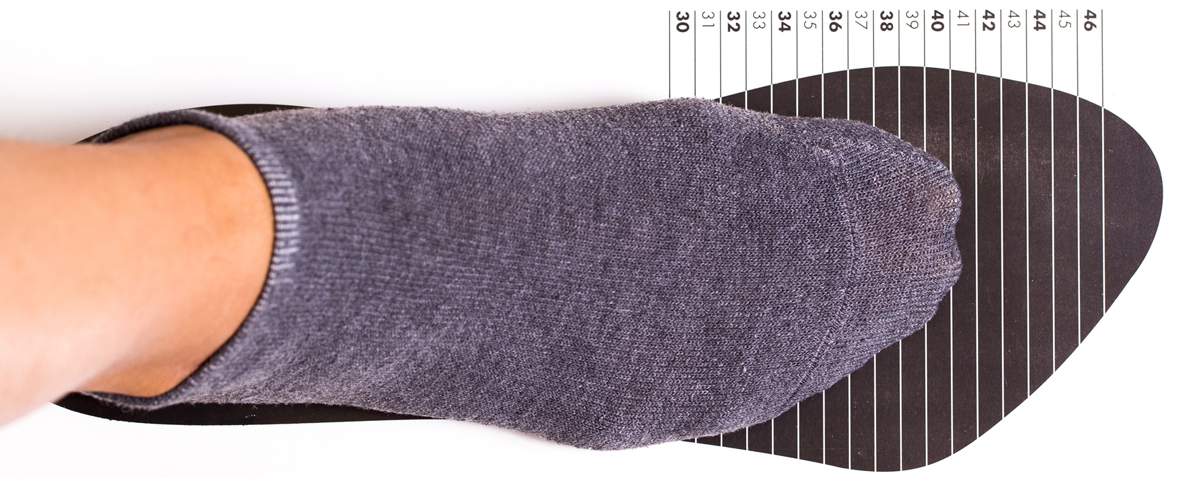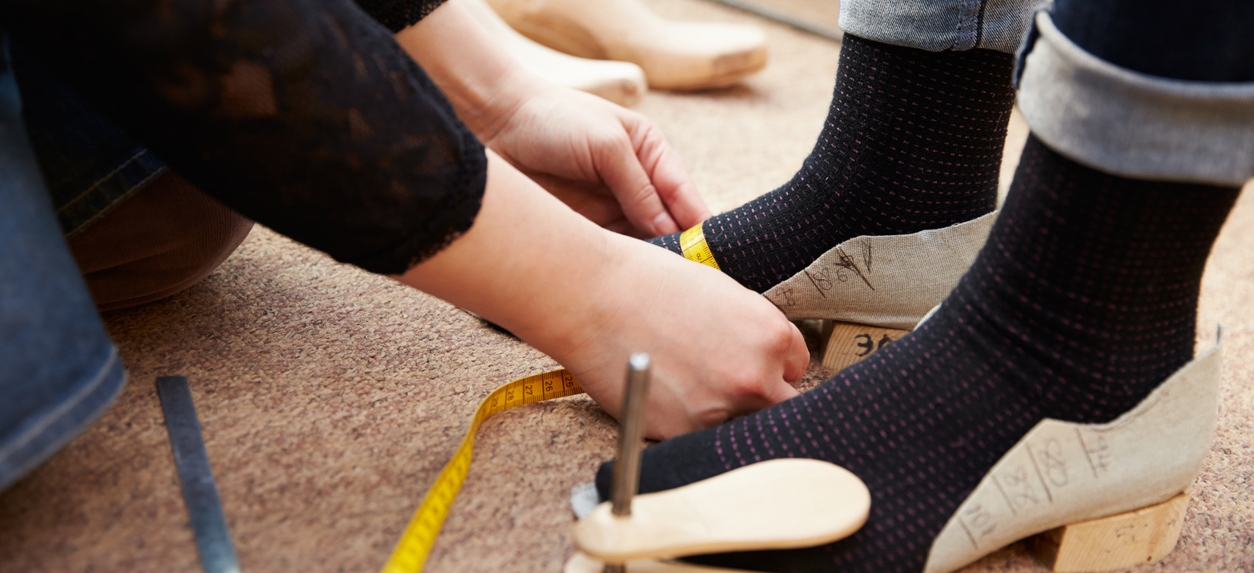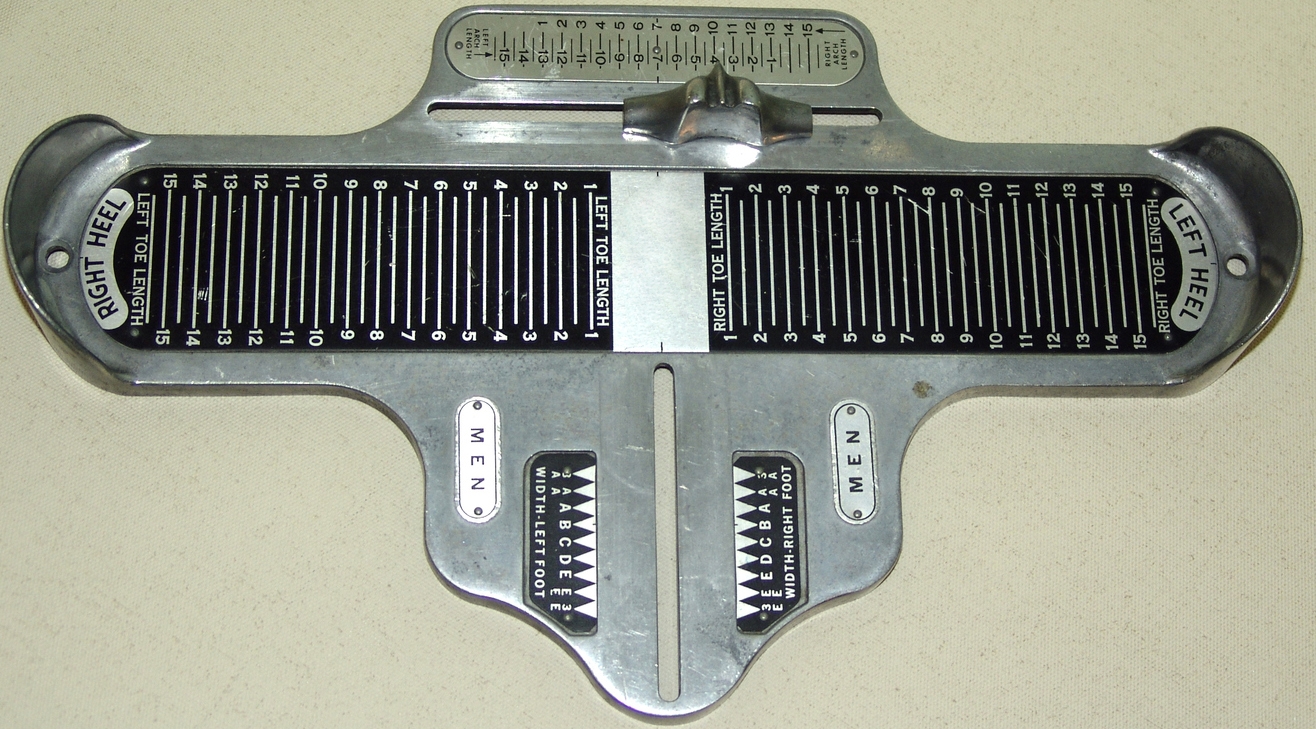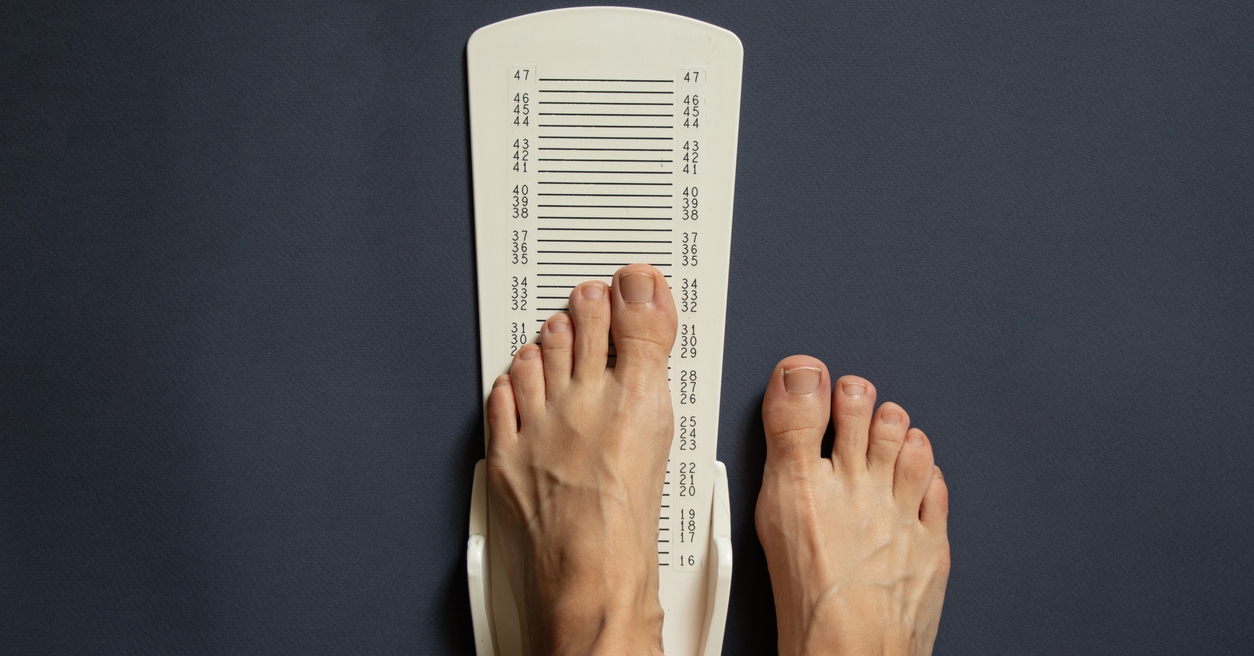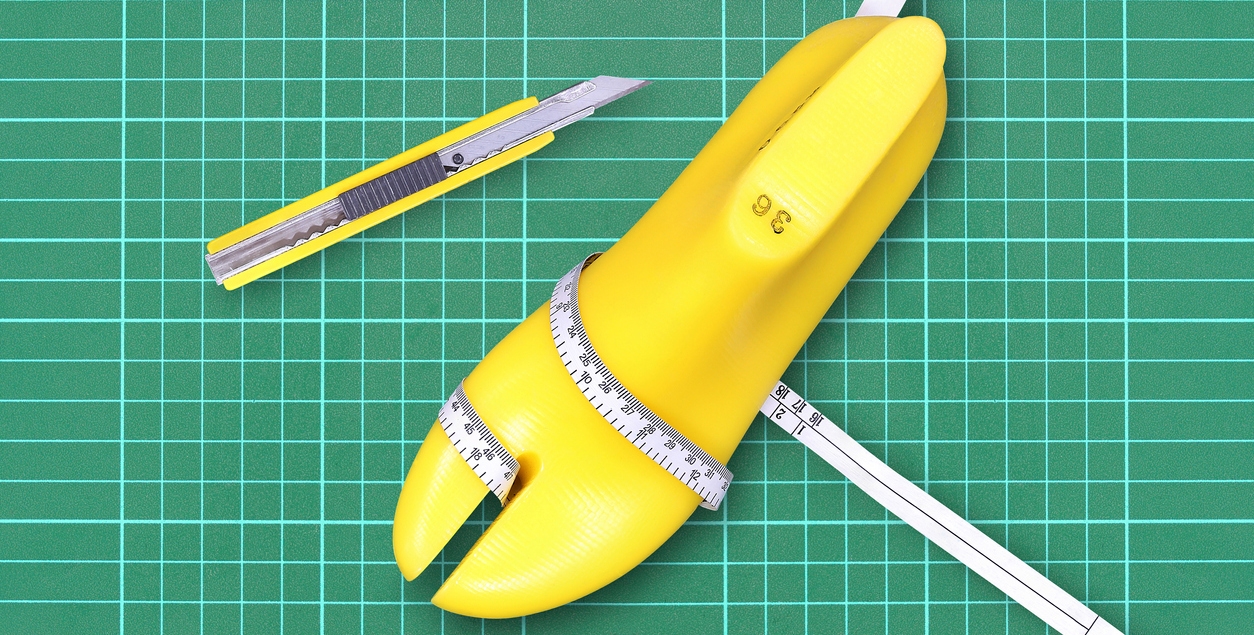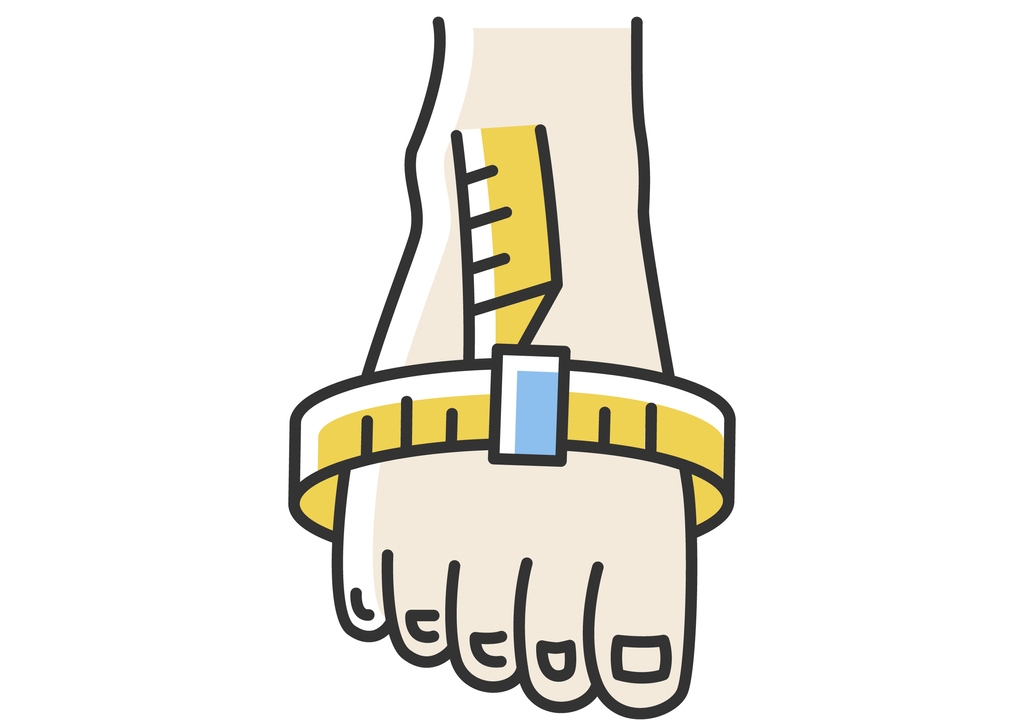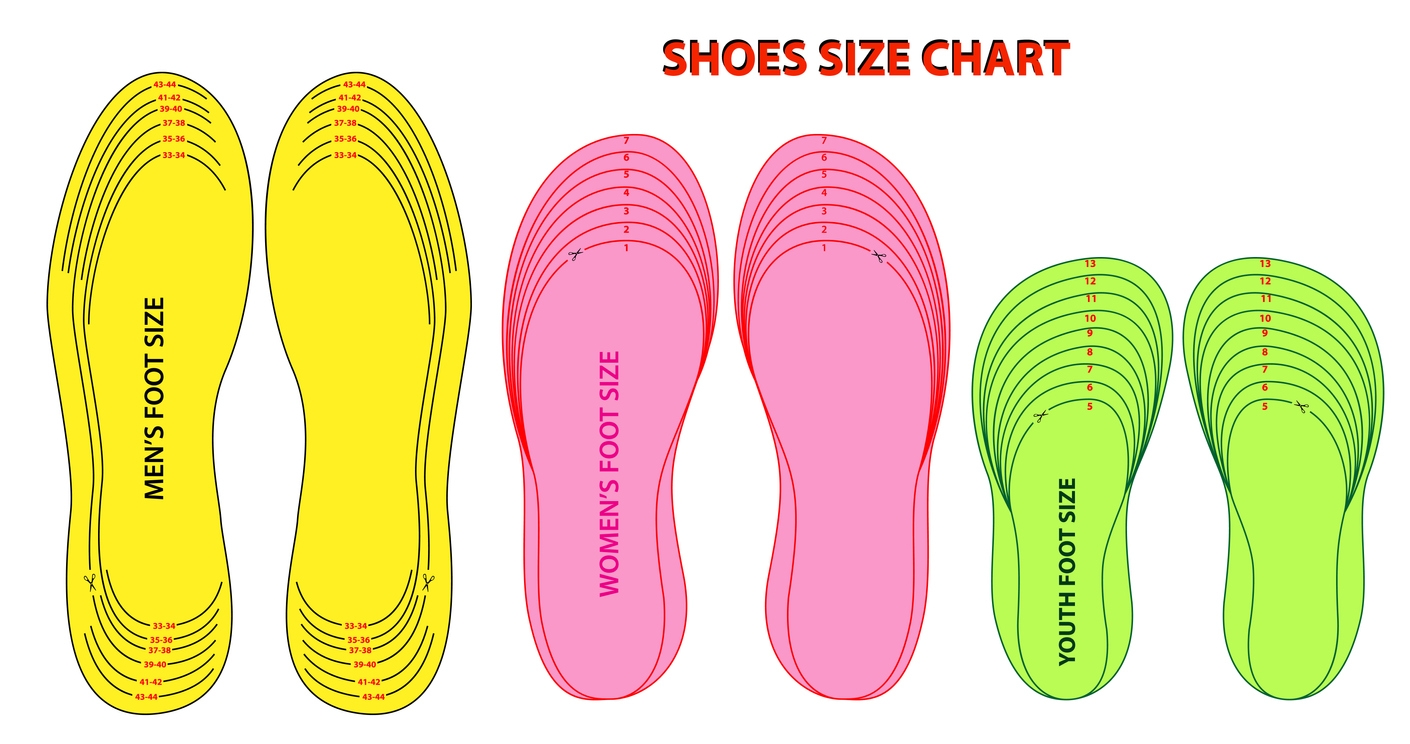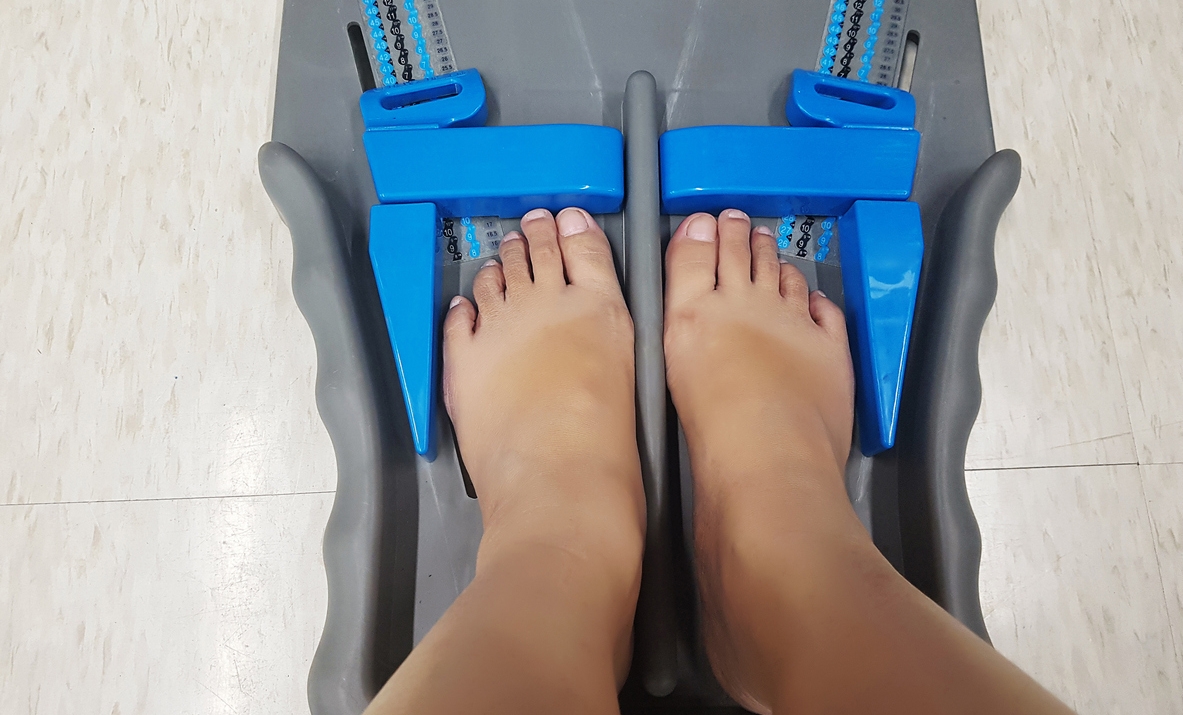Background
When buying shoes, one of the most important things that you need to consider is your shoe size, especially now that shoes can be ordered online. However, the challenging part is that sometimes, the sizing of shoes varies depending on the brand, where it is made, and for what gender. Not all shoes come in standard sizes, which can make it confusing for consumers. That is why most shoe brands offer size conversions on their products, to help buyers compare different types of sizes and find the equivalent of their correct size.
Today, it is quite easy to find your shoe size as charts and calculators are available online. But have you ever wondered how shoe sizing started? Who do you think invented these shoe sizes? If you are also wondering about these, you’re in the right place. In this post, we are giving you everything you need to know about shoe sizes, including their history, different types, how to get your correct shoe size, and more interesting facts that you should know.
History of the Shoe Size System
Shoe size may not have been a major issue hundreds of years ago because shoes were either custom-made to fit each wearer’s feet or they were available in small, slightly bigger, and fairly large sizes when shopping. However, when history saw dramatic growth in population, commercialism, mechanism, and customer choice, it was inevitable that shoemakers would need to come up with a method of producing shoes in a specific range of sizes. [1]
The Early Days for Measuring Shoe Sizes
During ancient Roman times, barleycorn was used by shoemakers to measure people’s feet for sandals, and three barleycorns equal an inch of length. In 1324 England, during the reign of King Edward, a decree was signed to make barleycorn the standard shoe size system. If the shoe size is seven, it is equivalent to 21 barleycorns. For men, the average shoe size was 39 barleycorns. Did you know that this shoe size system is still used today in the United Kingdom and Ireland? Separate colonies that might have originated from England still use this method of shoe measuring. [2]
Written Records About Shoe Sizing
In Britain, the first description of a modern shoe sizing system used quarter-inch increments instead of those one-third inches. The Academy of Armory and Blazon, written by genealogist Randle Holme and published in 1688, contains the first known description of a system.
According to his writing, “The size of a shoe is determined by its length, which is divided into 13 parts for children and 15 parts for men and women. The shoe must be five inches long before a size can be determined; if it is longer, the shoe is divided into sizes 1, 2, and 3, and so on until it reaches size 12, also known as the boys’ or girls’ thirteens or the short thirteens, which has a length of 8 inches and a quarter.”
This shows that while some shoemakers produced sizes based on one barleycorn, or one-third of an inch increment, others sized their footwear every quarter inch. There are few written records concerning shoe sizing systems; the earliest one likely dates to 1856, the year Robert Gardiner of London published The Illustrated Handbook of the Foot, in which he mentioned that one-third of an inch separated sizes. Edwin Simpson, a New York merchant, created a thorough sizing method in 1880; the US industry as a whole adopted it around ten years later. [1]
Half Sizes
Even though the UK was the birthplace of the shoe sizing system being used there and in the United States, the American footwear industry quickly started to develop it further. In 1887, half sizes appeared in the US. This idea was adopted by British manufacturers and retailers. However, making shoes with one-sixth of an inch between sizes was not immediately popular because of the increased stock levels required. Also, most stores in the US only began offering half sizes at the turn of the century.
For a lot of retailers, consumers had lived without half sizes, and there was no real need to go to the added expense. But over the years, other store owners who aggressively marketed that the half sizes they stocked provided a better fit won. Their more hesitant competitors bowed to the inevitable business pressure and followed suit. [1]
Shoe Widths
American shoemakers also became the leaders in the production of footwear in various width fittings. It was proposed in the system introduced by Edwin Simpson in 1880. The US Retail Boot & Shoe Dealers’ Association finally adopted his idea after seven years. However, even by 1900, a sizable part of shoes sold in that nation was only offered in a single width fitting or occasionally in “slim” or “fat” styles.
When the 1920s came, an increased range of widths became generally available. At the present time, footwear buyers in the US and the UK have various width fittings to choose from. Depending on the manufacturer, these can range from very narrow to very wide, with a few options in between. [1]
The Modern Systems
From the rather crude methods of measuring, the shoe size systems being used today were developed in countries such as Australia, New Zealand, Ireland, Canada, the UK, and the USA. Remarkably, these countries then devised their own way of numbering shoe sizes. For instance, a UK woman’s size 5 is equivalent to a size 7 in the USA. In Australia and New Zealand, both of the systems are being used, depending on the gender of the wearer and the type of shoes involved.
Around 1913, in an effort to develop a shoe size guide, the Ritz Stick was invented and patented in 1916. It is a measuring tool that features a flat wooden scale with a fixed heel stop and sliding top stop. It is believed to be the first nationally recognized device for foot measurement in the United States. It was manufactured by American Automatic Devices Co, and it became very popular during the early 1920s. This device was modified in 1988 to include women’s sizing, and it is still being manufactured and used today. [1]
A few years after the introduction of the Ritz Stick, Charles Brannock, a New York-based inventor, apparently spent two years making a simple means of measuring the length, width, and arch length of the human foot. In the 1920s, his first prototype was patented, and he later formed the Brannock Device Company to manufacture and sell the product. He led the company until his death in 1992. The company was then bought by Salvatore Leonardi from the Brannock Estate in the following year and still manufactures several models of the device. [1]
Shoe Sizing Systems
In most cases, the length of a foot is determined by the distance between two parallel lines that cross the foot at the most prominent toe and heel. The individual must be standing barefoot with their body weight evenly distributed across both feet when having their feet measured. When the left and right feet are somewhat different in size, the larger foot is measured and used to determine the shoe size. [3]
Three Distinct Lengths
Each shoe can accommodate a small range of foot lengths. Although this relation varies across various types of shoes, the length of the inside cavity of a shoe must normally be 15-20 mm longer than the length of the foot. A shoe-size system can relate to one of three distinct lengths:
The average length of foot for which a shoe is suitable: It applies equally to shoes of every kind, shape, and construction. This measure is less popular among makers, though, as it necessitates that they carefully test each new shoe model to determine the range of foot sizes it is advised for. It places the responsibility of guaranteeing that the shoe will fit a foot of a specific length on the maker. [3]
The length of the inner cavity of the shoe: This measurement has the benefit of being simple to take on the finished product. The buyer is simply given very basic information regarding the range of foot sizes that the shoe is suitable for, and this information will vary depending on production limitations. [3]
The length of the “last”: This refers to the foot-shaped template that is used to make shoes. The maker may utilize this measurement the simplest because it merely identifies the tool used to make the shoe. It provides no guarantees regarding production tolerances or the actual foot size for which the shoe is suitable. It places the entire burden and risk of selecting the appropriate size on the customer. [3]
Length Units
The following length units are often used today to define shoe-size systems:
1. Customary Units:
- Barleycorn = 1/3 inch = 8.47mm
- Paris Point = 2/3 cm = 6.67mm = 0.26 inch
2. Metric Units
- Millimeter (mm) = 0.039 inch
- Centimeter (cm) = 10mm = 0.39 inch
Main Systems of Measurement
Different shoe sizing systems are used in various parts of the world, which can make identifying shoe sizes confusing for some people. To help you better understand them, below are the overviews of each of the main systems of measurement.
1. Paris Point
With the exception of England, the Paris point, also known as (Continental) European size, was developed by the French in the middle of the 19th century. This measuring unit is based on the length of a single double-stitched stitch, which is two-thirds of a centimeter long (6.67 mm). The sizes range from a children’s size 15, which is equal to 10 centimeters, to a men’s size 50. (33.3 centimeters). Half sizes are typically not available. The distance between sizes that follow one another is always 6.67 mm. [4]
The following formula is used to determine EU shoe sizes: (Length of the interior of the foot (in cm) + 1.5 cm) x 1.5
2. English Linear Measure
The world’s oldest method of sizing shoes is the English linear measure. One barleycorn, also known as one difference in size, has a diameter of one-third of an inch and a measurement of 8.46 mm (an inch is 2.54 cm). Half-sizes, with a 4.23 mm difference between each subsequent half-size, was established in 1880 to improve shoe fit.
English linear measure distinguishes between children’s and adult sizes in contrast to the Paris point-based system. The smallest reasonable size, 12 barleycorns, or 10.16 cm, or a child’s size 0, is where the children’s shoe size scale starts. Adult sizes range up to 14, whereas a child’s size 13 12 is equivalent to an adult size 1. (33 cm). [4]
The following formula is used to determine English shoe sizes: ((Length of the last (cm) / 2.54 x 3) – 25
3. American Linear Measure
The English linear measure is the foundation of the American shoe size system, which was developed in the middle of the 19th century. However, it differs from the English system in that the scale starts at 3 11/12 inches rather than 4 inches. So, using this scale, a child’s size 0 is equivalent to 15 Paris points.
This was done in order to, at least theoretically, cater to both the French system and the metric system. Usually, an American size correlates to an English size one size smaller. For instance, an American size 10 equates to an English size 9. A 14 (=32.8 cm) is the largest adult shoe size available in America. There are additional half-sizes available; the distance between adjacent half-sizes is 4.233 mm. [4]
The following formula is used to determine American shoe sizes: ((Length of the last (cm) / 2.54 x 3) – 23
4. Japanese Linear Measure
The length of the foot in centimeters serves as the foundation for the Japanese linear measurement system (JPN). This dimension is directly related to shoe size. A foot that is 25 cm long wears a JPN 25 shoe size, which is equivalent to a European size 40. Between sizes, there is a 5mm difference that lies somewhere between the continental European and British systems. [4]
5. Brannock Measurement System
The Charles Brannock measurement system is based on a measuring tool he used when selling shoes. This instrument, which bore Brannock’s name and was invented in 1929, measures both the absolute length of the foot and the distance between its widest point and the heel. Men’s size 1 corresponds to a foot length of 7 2/3 inches in this system (19.47 cm). Men can wear sizes up to 16. (33.02 cm). [4]
The following formula determines shoe sizes using the Brannock system: ((Foot length (cm) / 2.54 x 3) – 22
6. Mondopoint System
In an effort to create an internationally recognized method for sizing shoes, the International Organization for Standardization created the Mondopoint system in 1980. Prior linear measurements were based on the length of the outer sole or the last. The Mondopoint approach, however, solely considers the foot and is thus relevant regardless of the style of shoe.
The Mondopoint system is used to measure the length of the foot in millimeters, and the width of the foot is reported as a percentage. A Mondopoint shoe size 267/90, for instance, fits feet that are 26.7 cm long and 24 cm wide (90% of 267 mm foot length). The distance between each consecutive size is 5 mm. The technique was only used to determine ski boot sizes and failed to gain popularity. [4]
Shoe Width Measurements
It is also important to buy the right shoe for the width of your feet, as this can ensure a comfortable fit. Sport shoes typically contain fastenings that allow for adjustment, which makes it easier for most sports brands to carry the whole range of widths. [5]
It’s vital to keep in mind that the width size is also based on the length of your foot. Shoe width is typically specified with a letter or collection of letters, such as “D” or “EEEE,” however, occasionally, the letters are replaced by a combination of letters and digits, such as “4E.”
For instance, if you wear a size 8 and your foot measures 3 9/16 inches broad, this is regarded as a typical width. A broad shoe is necessary if your foot is 3 9/16 inches wide and you wear a size 5. Shoes for kids typically don’t come in different widths. [6]
It is worth the time and effort to discover the ideal pair of shoes if your feet are wider than average rather than settle for a design that won’t last very long or be very versatile because it doesn’t match many items in your wardrobe. [5]
Shoe Size Charts
If you are searching for some reference that you can use to know the length and width of your foot in various systems of measurement, you can take a look at the following charts:
Women’s Shoes Length Chart
Women’s Shoes Length Chart | |||||
Length (inches) | Length (centimeters) | US Size | UK Size | European Size | Japanese Size |
8 9/16″ | 21.6 cm | 5 | 3 | 35/36 | 22 |
8 3/4″ | 22.2 cm | 5.5 | 3.5 | 36 | 22.5 |
8 7/8″ | 22.5 cm | 6 | 4 | 36/37 | 23 |
9 1/16″ | 23 cm | 6.5 | 4.5 | 37 | 23.5 |
9 1/4″ | 23.5 cm | 7 | 5 | 37/38 | 24 |
9 3/8″ | 23.8 cm | 7.5 | 5.5 | 38 | 24.5 |
9 1/2″ | 24.1 cm | 8 | 6 | 38/39 | 25 |
9 11/16″ | 24.6 cm | 8.5 | 6.5 | 39 | 25.5 |
9 7/8″ | 25.1 cm | 9 | 7 | 39/40 | 26 |
10″ | 25.4 cm | 9.5 | 7.5 | 40 | 26.5 |
10 3/16″ | 25.9 cm | 10 | 8 | 40/41 | 27 |
10 3/8″ | 26.2 cm | 10.5 | 8.5 | 41 | 27.5 |
10 1/2″ | 26.7 cm | 11 | 9 | 41/42 | 28 |
10 11/16″ | 27.1 cm | 11.5 | 9.5 | 42 | 28.5 |
10 7/8″ | 27.6 cm | 12 | 10 | 42/43 | 29 |
Women’s Shoes Width Chart
Women’s Shoes Width Chart | ||||||||
US Size | Narrow (AA) (inches) | Narrow (AA) (cm) | Medium (M or B) (inches) | Medium (M or B) (cm) | Wide (D) inches | Wide (D) (cm) | Extra Wide (EE) (inches) | Extra Wide (EE) (cm) |
5 | 2 13/16″ | 7.1 cm | 3 3/16″ | 8.1 cm | 3 9/16″ | 9 cm | 3 15/16″ | 10 cm |
5.5 | 2 7/8″ | 7.3 cm | 3 1/4″ | 8.3 cm | 3 5/8″ | 9.2 cm | 4″ | 10.1 cm |
6 | 2 15/16″ | 7.5 cm | 3 5/16″ | 8.4 cm | 3 11/16″ | 9.4 cm | 4 1/16″ | 10.3 cm |
6.5 | 3″ | 7.6 cm | 3 3/8″ | 8.6 cm | 3 3/4″ | 9.5 cm | 4 1/8″ | 10.5 cm |
7 | 3 1/16″ | 7.8 cm | 3 7/16″ | 8.7 cm | 3 13/16″ | 9.7 cm | 4 3/16″ | 10.6 cm |
7.5 | 3 1/8″ | 8 cm | 3 1/2″ | 8.9 cm | 3 7/8″ | 9.9 cm | 4 1/4″ | 10.8 cm |
8 | 3 3/16″ | 8.1 cm | 3 9/16″ | 9 cm | 3 15/16″ | 10 cm | 4 5/16″ | 11 cm |
8.5 | 3 1/4″ | 8.3 cm | 3 5/8″ | 9.2 cm | 4″ | 10.1 cm | 4 3/8″ | 11.1 cm |
9 | 3 5/16″ | 8.4 cm | 3 11/16″ | 9.4 cm | 4 1/16″ | 10.3 cm | 4 7/16″ | 11.3 cm |
9.5 | 3 3/8″ | 8.6 cm | 3 3/4″ | 9.5 cm | 4 1/8″ | 10.5 cm | 4 1/2″ | 11.4 cm |
10 | 3 7/16″ | 8.7 cm | 3 13/16″ | 9.7 cm | 4 3/16″ | 10.6 cm | 4 9/16″ | 11.6 cm |
10.5 | 3 1/2″ | 8.9 cm | 3 7/8″ | 9.9 cm | 4 1/4″ | 10.8 cm | 4 5/8″ | 11.8 cm |
11 | 3 9/16″ | 9 cm | 3 15/16″ | 10 cm | 4 5/16″ | 11 cm | 4 11/16″ | 11.9 cm |
11.5 | 3 5/8″ | 9.2 cm | 4″ | 10.1 cm | 4 3/8″ | 11.1 cm | 4 3/4″ | 12.1 cm |
12 | 3 11/16″ | 9.4 cm | 4 1/16″ | 10.3 cm | 4 7/16″ | 11.3 cm | 4 13/16″ | 12.2 cm |
Men’s Shoes Length Chart
Men’s Shoes Length Chart | |||||
Length (inches) | Length (centimeters) | US Size | UK Size | European Size | Japanese Size |
9 1/4″ | 23.5 cm | 6 | 5.5 | 39 | 25 |
9 1/2″ | 24.1 cm | 6.5 | 6 | 39/40 | 25.5 |
9 5/8″ | 24.4 cm | 7 | 6.5 | 40 | 26 |
9 3/4″ | 24.8 cm | 7.5 | 7 | 40/41 | 26.5 |
9 15/16″ | 25.4 cm | 8 | 7.5 | 41 | 27 |
10 1/8″ | 25.7 cm | 8.5 | 8 | 41/42 | 27.5 |
10 1/4″ | 26 cm | 9 | 8.5 | 42 | 28 |
10 7/16″ | 26.7 cm | 9.5 | 9 | 42/43 | 28.5 |
10 9/16″ | 27 cm | 10 | 9.5 | 43 | 29 |
10 3/4″ | 27.3 cm | 10.5 | 10 | 43/44 | 29.5 |
10 15/16″ | 27.9 cm | 11 | 10.5 | 44 | 30 |
11 1/8″ | 28.3 cm | 11.5 | 11 | 44/45 | 31 |
11 1/4″ | 28.6 cm | 12 | 11.5 | 45 | 32 |
11 1/2″ | 29.2 cm | 12.5 | 12 | 45/46 | - |
11 9/16″ | 29.5 cm | 13 | 12.5 | 46 | - |
11 3/4″ | 30.2 cm | 13.5 | 13 | 46/47 | - |
12 3/16″ | 31 cm | 14 | 13.5 | 47 | - |
12″ | 31 cm | 14.5 | 14 | 47/48 | - |
12 1/8″ | 31.4 cm | 15 | 14.5 | 48 | - |
12 1/2″ | 32 cm | 16 | 15 | 49/50 | - |
13″ | 33 cm | 17 | - | - | - |
Men’s Shoes Width Chart
Men’s Shoes Width Chart | ||||||||||
US Shoe Size | Narrow (B) (inches) | Narrow (B) (cm) | Medium (D) (inches) | Medium (D) (cm) | Wide (EE) (inches) | Wide (EE) (cm) | Extra-Wide (4E) (inches) | Extra-Wide (4E) (cm) | Extra, Extra-Wide (6E) (inches) | Extra, Extra-Wide (6E) (cm) |
6 | 3 5/16 | 8.4 | 3 1/2 | 8.9 | 3 11/16 | 9.4 | 3 7/8 | 9.8 | 4 1/16 | 10.3 |
6.5 | 3 3/8 | 8.6 | 3 9/16 | 9 | 3 3/4 | 9.5 | 3 15/16 | 10 | 4 1/8 | 10.5 |
7 | 3 7/16 | 8.7 | 3 5/8 | 9.2 | 3 13/16 | 9.7 | 4 | 10.2 | 4 3/16 | 10.6 |
7.5 | 3 1/2 | 8.9 | 3 11/16 | 9.4 | 3 7/8 | 9.8 | 4 1/16 | 10.3 | 4 1/4 | 10.8 |
8 | 3 9/16 | 9 | 3 3/4 | 9.5 | 3 15/16 | 10 | 4 1/8 | 10.5 | 4 5/16 | 11 |
8.5 | 3 5/8 | 9.2 | 3 13/16 | 9.7 | 4 | 10.2 | 4 3/16 | 10.6 | 4 3/8 | 11.1 |
9 | 3 11/16 | 9.4 | 3 7/8 | 9.8 | 4 1/16 | 10.3 | 4 1/4 | 10.8 | 4 7/16 | 11.3 |
9.5 | 3 3/4 | 9.5 | 3 15/16 | 10 | 4 1/8 | 10.5 | 4 5/16 | 11 | 4 1/2 | 11.4 |
10 | 3 13/16 | 9.7 | 4 | 10.2 | 4 3/16 | 10.6 | 4 3/8 | 11.1 | 4 9/16 | 11.6 |
10.5 | 3 7/8 | 9.8 | 4 1/16 | 10.3 | 4 1/4 | 10.8 | 4 7/16 | 11.3 | 4 5/8 | 11.7 |
11 | 3 15/16 | 10 | 4 1/8 | 10.5 | 4 5/16 | 11 | 4 1/2 | 11.4 | 4 11/16 | 11.9 |
11.5 | 4 | 10.2 | 4 3/16 | 10.6 | 4 3/8 | 11.1 | 4 9/16 | 11.6 | 4 3/4 | 12.1 |
12 | 4 1/16 | 10.3 | 4 1/4 | 10.8 | 4 7/16 | 11.3 | 4 5/8 | 11.7 | 4 13/16 | 12.2 |
12.5 | 4 1/8 | 10.5 | 4 5/16 | 11 | 4 1/2 | 11.4 | 4 11/16 | 11.9 | 4 7/8 | 12.4 |
13 | 4 3/16 | 10.6 | 4 3/8 | 11.1 | 4 9/16 | 11.6 | 4 3/4 | 12.1 | 4 15/16 | 12.5 |
13.5 | 4 1/4 | 10.8 | 4 7/16 | 11.3 | 4 5/8 | 11.7 | 4 13/16 | 12.2 | 5 | 12.7 |
14 | 4 5/16 | 11 | 4 1/2 | 11.4 | 4 11/16 | 11.9 | 4 7/8 | 12.4 | 5 1/16 | 12.8 |
14.5 | 4 3/8 | 11.1 | 4 9/16 | 11.6 | 4 3/4 | 12.1 | 4 15/16 | 12.5 | 5 1/8 | 13 |
15 | 4 7/16 | 11.3 | 4 5/8 | 11.7 | 4 13/16 | 12.2 | 5 | 12.7 | 5 3/16 | - |
Children’s Shoe Size Chart
Children's Shoe Size Chart | |||||
Length (inches) | Length (centimeters) | US Size | UK Size | European Size | Japanese Size |
3 1/8″ | 7.9 cm | 0 | 0 | 15 | - |
3 1/2″ | 8.9 cm | 1 | 0.5 | 16 | - |
3 5/8″ | 9.2 cm | 1.5 | 1 | 17 | - |
3 3/4″ | 9.5 cm | 2 | 1 | 17 | - |
4″ | 10.2 cm | 2.5 | 1.5 | 18 | - |
4 1/8″ | 10.5 cm | 3 | 2 | 18 | 12 |
4 1/4″ | 10.8 cm | 3.5 | 2.5 | 19 | 12/12.5 |
4 1/2″ | 11.4 cm | 4 | 3 | 19 | 12.5 |
4 5/8″ | 11.7 cm | 4.5 | 3.5 | 20 | 12.5/13 |
4 3/4″ | 12.1 cm | 5 | 4 | 20 | 13 |
5″ | 12.7 cm | 5.5 | 4.5 | 21 | 13.5 |
5 1/8″ | 13 cm | 6 | 5 | 22 | 14 |
5 1/4″ | 13.3 cm | 6.5 | 5.5 | 22 | 14/14.4 |
5 1/2″ | 14 cm | 7 | 6 | 23 | 14.5 |
5 5/8″ | 14.3 cm | 7.5 | 6.5 | 23 | 14.5/15 |
5 3/4″ | 14.6 cm | 8 | 7 | 24 | 15 |
6″ | 15.2 cm | 8.5 | 7.5 | 25 | 14/15.5 |
6 1/8″ | 15.6 cm | 9 | 8 | 25 | 15.5 |
6 1/4″ | 15.9 cm | 9.5 | 8.5 | 26 | 16 |
6 1/2″ | 16.5 cm | 10 | 9 | 27 | 16.5 |
6 5/8″ | 16.8 cm | 10.5 | 9.5 | 27 | 16.5/17 |
6 3/4″ | 17.1 cm | 11 | 10 | 28 | 17 |
7″ | 17.8 cm | 11.5 | 10.5 | 29 | 17/17.5 |
7 1/8″ | 18.1 cm | 12 | 11 | 30 | 17.5 |
7 1/4″ | 18.4 cm | 12.5 | 11.5 | 30 | 18 |
7 1/2″ | 19.1 cm | 13 | 12 | 31 | 18.5 |
7 5/8″ | 19.4 cm | 13.5 | 12.5 | 31 | 18.5/19 |
7 3/4″ | 19.7 cm | 1 | 13 | 32 | 19 |
8″ | 20.3 cm | 1.5 | 14 | 33 | 19.5 |
8 1/8″ | 20.6 cm | 2 | 1 | 33 | 20 |
8 1/4″ | 21 cm | 2.5 | 1.5 | 34 | 20.5 |
8 1/2″ | 21.6 cm | 3 | 2 | 34 | 21 |
8 5/8″ | 21.9 cm | 3.5 | 2.5 | 35 | 21.5 |
8 3/4″ | 22.2 cm | 4 | 3 | 36 | 22 |
9″ | 22.9 cm | 4.5 | 3.5 | 36 | 22.5 |
9 1/8″ | 23.2 cm | 5 | 4 | 37 | 23 |
9 1/4″ | 23.5 cm | 5.5 | 4.5 | 37 | 23.5 |
9 1/2″ | 24.1 cm | 6 | 5 | 38 | 24 |
9 5/8″ | 24.4 cm | 6.5 | 5.5 | 38 | 24.5 |
9 3/4″ | 24.8 cm | 7 | 6 | 39 | 25 |
Tips to Get Your Shoe Size
More than having fashion in mind, you also need to consider function and keeping your feet in good shape when shopping for shoes. While getting a shoe that fits perfectly can be challenging, these tips might help you find the right size of shoes when you go shopping:
Trace your foot on paper.
When buying shoes, it is effective to take a tracing of your foot with you. You can place any shoe that you want to buy on top of the tracing. If the show is shorter or narrower than the tracing, then you can skip trying it on. [7]
Shop for shoes in the afternoon.
It is better to buy shoes in the afternoon because your foot expands naturally with use during the day.
Wear socks.
When purchasing shoes, it’s ideal if you can wear the same kind of socks that you’ll pair them with. This way, you can test whether or not it will be a comfortable fit on your foot.
Always measure your feet.
You can have a salesperson measure your feet. It is also essential to measure your feet every time you buy new shoes, as feet change with age, and they often grow larger and wider. Also, if one foot is larger than the other, buy a size that fits the larger foot. [7]
Interesting Facts About Shoes and Shoe Sizes
Here are more interesting facts about shoes and shoe sizes that you need to know:
- Shoe sizes were established in 1324 when King Edward II of England declared that the diameter of one barleycorn would represent one full shoe size. This is the standard of measure that is still used today.
- In the United States, the best-selling shoe size is 8.5 for women and 10.5 for men.
- 85% of people underestimate their size by at least a half size, so if you believe you know the size of your feet, you may be mistaken.
- Most people are unaware that as you get older, your foot size may increase by one and a half sizes or more. Your feet are likely to become flatter as you age, lengthening and/or widening. Your foot size may also fluctuate as a result of additional variables like weight changes, surgery, and pregnancy.
- The first people to create separate left and right shoes were the ancient Romans. Before then, any shoe could be worn on either foot.
- Did you realize there might be a reason why people think infants’ feet are so adorable? Every baby is born with a fat pad in place of the arch that an adult foot would have. Children’s arches typically don’t develop until they are between two and two and a half years old.
- Heels have long been a sign of great social position rather than of gender. In order to stay in their stirrups, it was also essential for men riding horses to wear a heel on their boots.
- Sneakers were originally called “sneaks” because they allowed the wearer to move stealthily and silently while walking. The name eventually changed into “sneakers,” which we now know and love.
- Sanctions and shortages during World War II in the 1940s had an impact on the entire world. Salvatore Ferragamo was unable to obtain steel in Italy to make high heels. He instead experimented with Sardinian cork. In his experiments, he added cork to a shoe’s sole, giving rise to the infamous wedge.
- The earliest shoes discovered are from 8,000 years ago.
- Periods in history have seen kings enact regulations governing footwear for personal reasons. That is, at least, how the legend goes. For instance, King Henry VIII, who is now notorious for having several of his wives murdered, loved wide-tied shoes. He benefited from the wide-ties because of his severe gout. He consequently enacted a rule requiring ties to be at least six inches wide.
- The footwear business was founded thanks to the sewing machine and other innovations made during the Industrial Revolution. Shoes were handcrafted and frequently fairly expensive before this time. But most people in developed nations owned at least one pair of shoes by the late 1800s.
- Golden Lotus Feet were particularly popular among the affluent during the 10th and 11th centuries in China. Young girls’ feet were broken and deformed in this custom, so they could fit into unique shoes that resembled the flower. Small and delicate feet were seen as lovely by society. Unfortunately, this treatment rendered many women permanently unable to walk normally.
- A pointed toe on Mexican cowboy boots can be up to 39 inches long (99.06 cm).
- Shoemaking used to be one of the many family businesses that were passed down from one generation to another.
Conclusion
While it can sometimes be confusing to find the right shoe size, particularly when buying shoes from other countries, learning about the various systems of measurement can help. This way, you’ll be able to easily find or convert your shoe size to other systems of measurement and get the right size of shoes that will fit you comfortably. It is also amazing to learn that it was from using barleycorns to measure feet that the concept of shoe sizing originated and that it is still being used today. We hope this post helped you learn more about shoe sizes.
References
[1] Morgan, S. (2016, June). The development of footwear sizing systems. Satra Technology. Retrieved September 13, 2022, from https://www.satra.com/bulletin/article.php?id=1679
[2] O’Connor, B. (2022, April 5). The interesting history of shoe sizes. All Good Wedding. Retrieved September 13, 2022, from https://www.allgoodwedding.com/p/the-interesting-history-of-shoe-sizes/
[3] Footwears Info Online, E. (n.d.). Shoe Sizing Systems. Shoe sizing systems: Footwears Infoline. Retrieved September 13, 2022, from https://footwearsinfoline.tripod.com/shoe_sizeing.htm
[4] Shoepassion, E. (n.d.). Shoe Size Conversion. Find the right shoe size, anywhere in the world – SHOEPASSION.com. Retrieved September 13, 2022, from https://www.shoepassion.eu/shoe-encyclopaedia/proper-fit/size-conversion#
[5] The FitMyfoot, E. T. (2022, August 1). Shoe Width Chart. FitMyFoot. Retrieved September 13, 2022, from https://fitmyfoot.com/blogs/footprints/shoe-width-chart
[6] Size Charter, E. (n.d.). Understanding shoe sizing. SizeCharter. Retrieved September 13, 2022, from https://www.sizecharter.com/clothing-fit-and-measurement/understanding-shoe-sizing
[7] Harvard Health Publishing, E. (2015, June 11). 10 tips for finding the right shoes. Harvard Health. Retrieved September 13, 2022, from https://www.health.harvard.edu/staying-healthy/10-tips-for-finding-the-right-shoes
[8] TheRightShoe, E. (2017, October 23). 9 fun facts about shoes and feet. The Right Shoe. Retrieved September 13, 2022, from https://therightshoe.net/9-fun-facts-shoes-feet/
[9] Chong, D. A. (2020, February 25). 12 facts about shoes you didn’t know-until now. Who What Wear. Retrieved September 13, 2022, from https://www.whowhatwear.com/fun-facts-shoes/slide2
[10] Sherifi, M. (2022, April 12). 20 fun facts about shoes that will amaze you (2022 facts). Fun Facts About. Retrieved September 13, 2022, from https://www.funfactsabout.com/facts-about-shoes/
[11] Kidadl, T. (2022, September 8). Funny facts about shoes here’s everything you should know. Kidadl. Retrieved September 13, 2022, from https://kidadl.com/facts/funny-facts-about-shoes-here-s-everything-you-should-know

